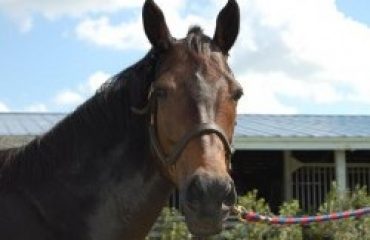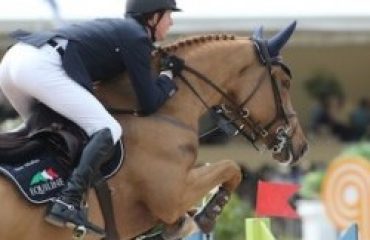 A sought-after trainer and clinician, American Olympic dressage rider Christine Traurig was born and raised on her parents’ breeding farm near Verden, Germany. She rode and trained for the Hanoverian Elite Sales in Verden before moving to the United States in 1982, where she assisted Bernie Traurig in operating an import and sales business of dressage horses and jumpers. Christine and Bernie were instrumental in establishing the Saudi Arabian Equestrian Team and Federation. With her equine partner Etienne, Christine was a member of the 2000 Sydney Olympic bronze-medal team. She now operates Christine Traurig Dressage Stables, Inc. in Rancho Santa Fe, California. She conducts clinics and symposiums all over the U.S. and in 2015, was appointed to the position of USEF National Coach for Young Dressage Horses. Do you have a question you want Christine to answer? Send questions to editor@sidelinesnews.com.
A sought-after trainer and clinician, American Olympic dressage rider Christine Traurig was born and raised on her parents’ breeding farm near Verden, Germany. She rode and trained for the Hanoverian Elite Sales in Verden before moving to the United States in 1982, where she assisted Bernie Traurig in operating an import and sales business of dressage horses and jumpers. Christine and Bernie were instrumental in establishing the Saudi Arabian Equestrian Team and Federation. With her equine partner Etienne, Christine was a member of the 2000 Sydney Olympic bronze-medal team. She now operates Christine Traurig Dressage Stables, Inc. in Rancho Santa Fe, California. She conducts clinics and symposiums all over the U.S. and in 2015, was appointed to the position of USEF National Coach for Young Dressage Horses. Do you have a question you want Christine to answer? Send questions to editor@sidelinesnews.com.
Do you have any tips for memorizing tests?
First I memorize the test in segments like the trot work, then walk work, then canter. I always memorize the test by having a dressage arena diagram in front of me so when I memorize the pattern from letter to letter, I have a visual of the arena. On the competition day, I sit ringside and do my imagery, visualizing myself and my horse in the arena riding the test. It’s also helpful for some riders to go through the test on foot by drawing a little arena on the ground, in the barn aisle for example, and then walking through the test.
Do you lunge your horses?
Yes, I lunge my horses. I have several reasons for it. First, when a young horse is a bit fresh, it’s most certainly safer to lunge a little first with tack and side reins to give the horse a chance to loosen up and get some bucks out. Also, I lunge my horses to put a little variety in the training program. Lunging should never be a method to make the horse tired but should have structure and a training purpose, such as in side reins to accept the bit, or transitions from trot to canter and back to trot in order to improve balance and looseness through the back. Finally, lunging in side reins over cavaletti is a wonderful way to encourage the horse to descend its neck and use its back.
What advice would you give a beginning rider learning to sit the trot?
Lunge line lessons! For a rider to sit the trot properly, they need to develop an independent seat, which means a balanced seat with the motion of the horse. I suggest starting on the lunge line on a horse that doesn’t move too big, no stirrups. Encourage the rider to hold on to the pommel of the saddle with one hand to secure the seat towards the front of the saddle — not the back, which we see way too often nowadays. No reins, the instructor handling the horse on the lunge and the side reins take care of the horse staying on the circle. When the rider can sit the trot with both of his/her arms hanging down relaxed next to his/her body, the rider can pick up the stirrups and the reins.
How do you use goals in your training, such as for certain levels or shows?
The horse determines the goal and the path to achieve it. A good rider/horseman knows how to assess the horse’s stages in training and mental and physical growth. This determines what goals are possible to achieve and which ones aren’t in relation to the levels you want to show at. It’s pretty simple: If your horse isn’t supple and relaxed, it’s going to be difficult to develop proper impulsion and straightness, which again means it’s going to be hard to collect your horse properly, which means that to show at a level that demands an increased development of collection will be a goal of the near future but needs attention to the details in the basics now in the present.
Do you give your students any off-horse “homework” like watching riders or competitions and looking for certain things?
I expect my students to study riding and horsemanship off their horses: read books, read articles, watch videos, watch good riders at the show in the warm up and in the competition, listen to other coaches teach. Becoming a good rider is not a one-hour lesson per day: it’s a commitment to a sport, and it becomes your lifestyle. I do realize, of course, that not every rider has the same goals and there most certainly is a variety of them, but the ones who have high aspirations have to live it and love it!
Should every horse be able to learn dressage, even if they don’t like it?
Not every horse is made conformationally or mentally to do the sport of dressage. However, dressage means training! This again means that every horse can be trained to respond to basic aids, like stop, start, driving, yielding, bending and containing aids. These fundamental aids, trained properly, will make the ride for the horse and the rider more enjoyable and harmonious no matter what breed the horse is or what ability the horse has for any discipline. Not every horse is made/built to do dressage to the highest level. That’s why horses are being bred for certain disciplines. When a rider feels that training the horse becomes force, then the rider need to reconsider the possibilities.













